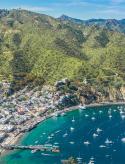It’s no surprise that life on Catalina bears little resemblance to what life on the island was like a thousand years ago. Unlike the Southern California mainland however, it’s relatively easy to peer through the veil of time and imagine life here.
This island has been inhabited for at least 8,000 years and possibly much longer. Native islanders made the island, which they called Pimu, home for generations, creating culture, crafting art and trading with the mainland. These early island residents were closely related to the Tongva people of the Southern California mainland.
Much of island Tongva culture was obscured as the islanders were forced from Pimu and inured at Mission San Gabriel by Spanish missionaries, but the archeological record and the Tongva people provide a fascinating glimpse at what island life was like before the Europeans arrived.
Several thousand people at a time lived on the island, scattered among villages in places we now know as Avalon, Little Harbor, Toyon Bay and Two Harbors, which was probably the largest of the villages. Not surprisingly, the ocean’s bounty was the source of much of the island Tongva diet, including an array of fish as well as abalone, crab, lobster and octopus. Marine mammals, such as seal lions, dolphins and whales were also hunted.
A rich sea-faring and trading culture
The 20-plus miles between the island and the mainland were frequently crossed by native islanders, who crafted dugout canoes known as ti’ats to challenge the wind, weather and waves in the channel. Those canoes would be laden with trade goods: woven baskets, preserved fish and abalone shell adornments – as well as highly desirable steatite.
Steatite, commonly known as soapstone, can be found in several locations on the island and native islanders used it for an array of applications. Advantageous for its ability to be quarried and carved with relatively primitive tools, soapstone can be crafted into cooking implements, storage containers, eating dishes as well as jewelry and amulets. Catalina soapstone has been found throughout the California coast, with large cooking vessels known as ollas particularly prevalent.
Once their visit was complete, intrepid paddlers would return to their island home with their ti’ats laden with mainland treasures, including useful obsidian as well as deer hides and other furs.
Island people did not only trade with mainland tribes, they would also visit the other Channel Islands, including those islands now known as San Clemente, Santa Barbara and San Nicholas. It was from one of the visits to the northern Channel Islands that naturalists believe the island fox was introduced to the island. Curious and unafraid, foxes are believed to have been part of islanders’ lives, living a semi-tamed life alongside their human companions.
Like many of California’s tribes, the island’s native people did not fare well after Europeans arrived on the west coast of North America. By 1830, all of them had been removed to missions on the mainland, where challenging conditions decimated their numbers.
Today, evidence of early islanders can be found at several locations on what we now know as Catalina Island. The Catalina Museum for Art & History is home to an extensive collection of island artifacts, including jewelry, fishing hooks, ollas and more. At the Airport in the Sky, visitors can see several soapstone bowls and other implements. Nearby, a short hike leads to a soapstone quarry, where the efforts of early carvers can clearly be seen, etched into eternity.
The Catalina Conservancy recently worked with Tongva experts and tribal representatives to create a brief video about the indigenous history of the Island and its soapstone quarry.


